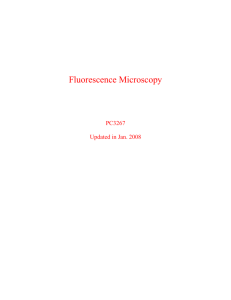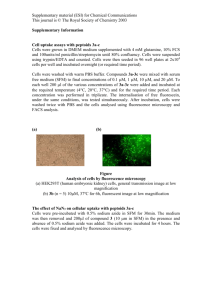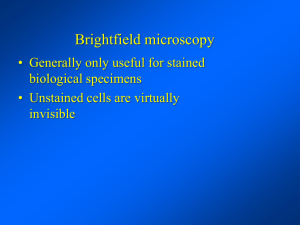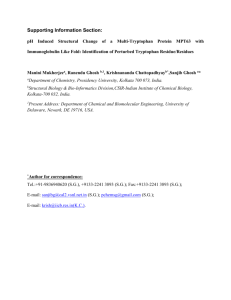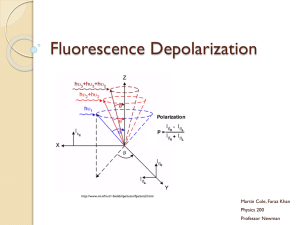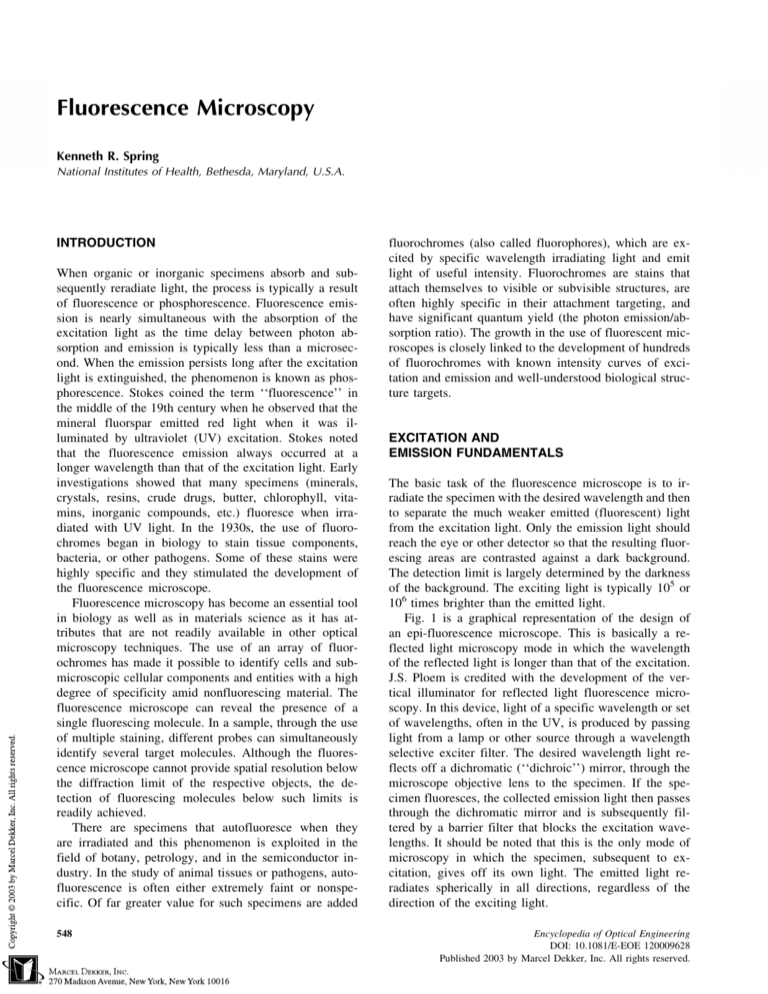
Fluorescence Microscopy
Kenneth R. Spring
National Institutes of Health, Bethesda, Maryland, U.S.A.
INTRODUCTION
When organic or inorganic specimens absorb and subsequently reradiate light, the process is typically a result
of fluorescence or phosphorescence. Fluorescence emission is nearly simultaneous with the absorption of the
excitation light as the time delay between photon absorption and emission is typically less than a microsecond. When the emission persists long after the excitation
light is extinguished, the phenomenon is known as phosphorescence. Stokes coined the term ‘‘fluorescence’’ in
the middle of the 19th century when he observed that the
mineral fluorspar emitted red light when it was illuminated by ultraviolet (UV) excitation. Stokes noted
that the fluorescence emission always occurred at a
longer wavelength than that of the excitation light. Early
investigations showed that many specimens (minerals,
crystals, resins, crude drugs, butter, chlorophyll, vitamins, inorganic compounds, etc.) fluoresce when irradiated with UV light. In the 1930s, the use of fluorochromes began in biology to stain tissue components,
bacteria, or other pathogens. Some of these stains were
highly specific and they stimulated the development of
the fluorescence microscope.
Fluorescence microscopy has become an essential tool
in biology as well as in materials science as it has attributes that are not readily available in other optical
microscopy techniques. The use of an array of fluorochromes has made it possible to identify cells and submicroscopic cellular components and entities with a high
degree of specificity amid nonfluorescing material. The
fluorescence microscope can reveal the presence of a
single fluorescing molecule. In a sample, through the use
of multiple staining, different probes can simultaneously
identify several target molecules. Although the fluorescence microscope cannot provide spatial resolution below
the diffraction limit of the respective objects, the detection of fluorescing molecules below such limits is
readily achieved.
There are specimens that autofluoresce when they
are irradiated and this phenomenon is exploited in the
field of botany, petrology, and in the semiconductor industry. In the study of animal tissues or pathogens, autofluorescence is often either extremely faint or nonspecific. Of far greater value for such specimens are added
548
fluorochromes (also called fluorophores), which are excited by specific wavelength irradiating light and emit
light of useful intensity. Fluorochromes are stains that
attach themselves to visible or subvisible structures, are
often highly specific in their attachment targeting, and
have significant quantum yield (the photon emission/absorption ratio). The growth in the use of fluorescent microscopes is closely linked to the development of hundreds
of fluorochromes with known intensity curves of excitation and emission and well-understood biological structure targets.
EXCITATION AND
EMISSION FUNDAMENTALS
The basic task of the fluorescence microscope is to irradiate the specimen with the desired wavelength and then
to separate the much weaker emitted (fluorescent) light
from the excitation light. Only the emission light should
reach the eye or other detector so that the resulting fluorescing areas are contrasted against a dark background.
The detection limit is largely determined by the darkness
of the background. The exciting light is typically 105 or
106 times brighter than the emitted light.
Fig. 1 is a graphical representation of the design of
an epi-fluorescence microscope. This is basically a reflected light microscopy mode in which the wavelength
of the reflected light is longer than that of the excitation.
J.S. Ploem is credited with the development of the vertical illuminator for reflected light fluorescence microscopy. In this device, light of a specific wavelength or set
of wavelengths, often in the UV, is produced by passing
light from a lamp or other source through a wavelength
selective exciter filter. The desired wavelength light reflects off a dichromatic (‘‘dichroic’’) mirror, through the
microscope objective lens to the specimen. If the specimen fluoresces, the collected emission light then passes
through the dichromatic mirror and is subsequently filtered by a barrier filter that blocks the excitation wavelengths. It should be noted that this is the only mode of
microscopy in which the specimen, subsequent to excitation, gives off its own light. The emitted light reradiates spherically in all directions, regardless of the
direction of the exciting light.
Encyclopedia of Optical Engineering
DOI: 10.1081/E-EOE 120009628
Published 2003 by Marcel Dekker, Inc. All rights reserved.
Fluorescence Microscopy
549
F
Fig. 1 Cut-away diagram of an upright microscope equipped both for transmitted light and epi-fluorescence microscopy. The vertical
illuminator in the center of the diagram has the light source at one end (episcopic lamphouse) and the filter cube at the other.
Epi-fluorescence is the overwhelming choice in modern microscopy and the reflected light vertical illuminator is interposed between the observation viewing tubes
and the nosepiece carrying the objectives. The illuminator
is designed to direct light onto the specimen by first
passing the light through the microscope objective on the
way toward the specimen and then using that same objective to capture the emitted light. This type of illuminator has several advantages: the objective—first serving
as a well-corrected condenser and then as the imageforming light gatherer—is always in correct alignment;
most of the unused excitation light reaching the specimen passes through it and travels away from the objective; the illuminated area is restricted to that which is
observed; the full numerical aperture (n.a.) of the objective, in Koehler illumination, is utilizable; it is possible to combine or alternate reflected light fluorescence
with transmitted light observation.
The reflected light illuminator has, at its far end, a
lamphouse containing a light source, usually a mercury or
xenon burner (the episcopic lamphouse in Fig. 1). The
light travels along the illuminator perpendicular to the
optical axis of the microscope, passes through collector
lenses and a variable, centerable aperture diaphragm, and
then through a variable, centerable field diaphragm (apertures in Fig. 1). It impinges upon the excitation filter
where selection of the excitation wavelength light and
blockage of undesired wavelengths occurs. The selected
wavelengths reach the dichromatic beamsplitting mirror.
This is a special type of interference filter that efficiently
reflects shorter wavelength light and efficiently passes
longer wavelength light. The dichromatic beam splitter
(also sometimes called the dichroic mirror, as shown in
Fig. 1) is tilted at 45° to the incoming excitation light and
reflects the excitation light at a 90° angle directly through
the objective and onto the specimen. The fluorescent light
550
Fluorescence Microscopy
if the housing is inadvertently opened during operation.
The lamphouse should be sturdy enough to withstand
a possible burner explosion during operation. The lamp
socket should have adjustment screws to permit centering the image of the lamp arc or halogen lamp coil to
the back aperture of the objective (in Koehler illumination, these planes are conjugate). In the light path, closer
to the lamphouse and before the excitation filter, it is
desirable to have a shutter for complete blocking of excitation light as well as neutral density filters on a wheel
or slider to permit reduction of light intensity.
STOKES’ SHIFT
Fig. 2 A microscope filter cube containing the exciter and
barrier filters as well as the dichromatic mirror.
emitted by the specimen is gathered by the objective, now
serving in its usual image-forming function. Because the
emitted light consists of longer wavelengths, it is able to
pass through the dichroic mirror.
Any scattered excitation light reaching the dichroic
mirror is reflected toward the light source. Before the
emitted light can reach the eyepiece or detector, it is
incident upon and passes through the barrier or suppression filter. This filter blocks (suppresses) any residual
excitation light and passes the desired longer emission
wavelengths. In most reflected light fluorescence illuminators, the excitation filter, dichroic mirror, and barrier filter are incorporated in a cube, as illustrated in
Fig. 2. Most microscopes accommodate three or four
fluorescence cubes (on a revolving turret or on a slider
as shown in Fig. 1) and permit the user to attach replacement custom-made exciters, barrier filters, or dichroic mirrors.
The design of the illuminator should permit the user to
employ the desirable Koehler Illumination, providing
bright and even illumination across the field of view. The
corrected condensing lenses of the system ensure that the
image of the centerable aperture diaphragm is conjugate
with the back aperture of the focused objective. The
image of the prefocused, centerable field diaphragm is
conjugate with the focused specimen and the plane of the
fixed eyepiece diaphragm.
The illuminator lamphouse usually incorporates an
infrared suppression filter. The lamphouse itself should
not leak harmful UV wavelengths and, preferably, should
incorporate a switch to automatically shut down the lamp
When electrons go from the excited state to the ground
state, there is a loss of vibrational energy. As a result, the
emission spectrum is shifted to longer wavelengths than
the excitation spectrum (wavelength varies inversely to
radiation energy). This phenomenon is known as Stokes’
Law or Stokes’ shift. The greater the Stokes’ shift, the
easier it is to separate excitation light from emission light.
The emission intensity peak is usually lower than the
excitation peak; and the emission curve is often a mirror
image of the excitation curve, but shifted to longer wavelengths (Fig. 3). To achieve maximum fluorescence intensity, the dye is usually excited at wavelengths near or
at the peak of the excitation curve, and the widest possible
range of emission wavelengths that include the emission
peak are selected. The selection of excitation wavelengths
and emission wavelengths is typically based on interference filters. In addition, the spectral response of an optical
system will depend on such factors as glass transmission
and detector responsivity.
Fig. 3 Absorption and emission spectra are shown for
fluorescein.
Fluorescence Microscopy
The separation of excitation and emission wavelengths
is achieved by the proper selection of filters to block or
pass specific wavelengths of the spectrum. The design of
fluorescence illuminators is based on the control of excitation light and emission light by readily changeable
filter insertions in the light path on the way toward the
specimen and then emanating from the specimen. It is
important, in view of low emission intensities, that the
light source chosen for excitation be of sufficient brightness so that the relatively weak emission light can be
maximized; and that fluorochromes of satisfactory absorption and yield be chosen.
The efficiency with which the fluorochrome absorbs a
photon of the excitation light is a function of molecular
cross-section, and the likelihood of absorption is known
as the extinction coefficient. Larger extinction coefficients mean that the absorption of light in a given wavelength region is more likely. The quantum yield denotes
the ratio of the number of quanta emitted compared to
those absorbed (usually the yield is between 0.1 and
1.0). Quantum yields below 1 are the result of the loss
of energy through nonradiative pathways (e.g., heat or
photochemical reaction) rather than the reradiative pathway of fluorescence. Extinction coefficient, quantum
yield, mean luminous intensity of the light source, and
fluorescence lifetime are all important factors that contribute to the intensity and utility of fluorescence emission.
FADING
There are conditions that may affect the reradiation of
light and thus reduce the intensity of fluorescence. This
reduction of emission intensity is generally called fading
and is further subdivided into quenching and bleaching.
Bleaching is the irreversible decomposition of the fluorescent molecules in the excited state because of their
interaction with molecular oxygen. The occurrence of
bleaching is exploited in a technique known as fluorescence recovery after photobleaching (FRAP), to study
diffusion and motion. It is based upon bleaching a
sharply defined region of the specimen by an intense
burst of laser light and subsequently observing the rate
and pattern of the recovery of fluorescence in the
bleached area. Quenching reduces fluorescence intensity
by a variety of mechanisms involving nonradiative energy loss and frequently comes about as a result of oxidizing agents or the presence of salts of heavy metals or
halogen compounds. Sometimes quenching results from
the transfer of energy to other so-called acceptor molecules physically close to the excited fluorophores, a phenomenon known as resonance energy transfer. This
particular phenomenon has become the basis of the technique called fluorescence resonance energy transfer
551
(FRET) for studying molecular interactions and associations at distances far below the lateral resolution of the
light microscope.
LIGHT SOURCES
In most fluorescence microscopy applications, the number
of photons that reach the eye or detector is usually very
low. This is because the collection efficiency of microscopes is less than 30% and the concentration of most
fluorochromes in the optical path is low (usually micromolar or nanomolar). To generate sufficient excitation
light intensity to produce detectable emission, powerful
compact light sources are needed, usually short arc lamps.
The most common lamps are the mercury burners, ranging in wattage from 50 to 200 W and the xenon burners
ranging from 75 to 150 W. These light sources are
powered by a direct current (d.c.) supply, furnishing
enough start-up power to ignite the burner (by ionization
of the gaseous vapor) and to keep it burning with a
minimum of flicker. The power supply should have a
timer to track the number of hours the burner has been in
use. Arc lamps lose efficiency and are more likely to
shatter, if used beyond their rated lifetime. The mercury
burners do not provide even intensity across the spectrum
from UV to infrared and much of the intensity of the
mercury burner is expended in the near UV. Prominent
peaks of intensity occur at 313, 334, 365, 406, 435, 546,
and 578 nm. At other wavelengths of visible light, the
intensity is steady although not nearly so bright, but still
usable. Mere lamp wattage is not the prime consideration;
instead, the critical parameter is the mean luminance that
takes into account the source brightness, arc geometry,
and the angular spread of emission.
In recent years, there has been increasing use of
lasers, particularly the argon-ion and argon –krypton-ion
lasers as light sources. They have the virtues of small
source size, low divergence, monochromaticity, and high
mean luminance. They have become essential in scanning confocal microscopy, a technique that has proved to
be a powerful tool in rendering very sharp fluorescence
images by rejecting out-of-focus light. This is accomplished through point or line scanning and coincident
imaging through a conjugate aperture. Optical sections
of the specimen are stored in a computer and reconstituted into the whole image that then can be displayed
on a monitor.
FILTER TERMINOLOGY
The terminology applied to fluorescence filters has become a jumble as a result of various initials utilized by
F
552
different manufacturers to identify their filters. Basically,
there are three categories of filters: exciter filters, barrier
filters, and dichromatic beam splitters (dichroic mirrors).
Fluorescence filters were formerly almost exclusively
made of colored glass or colored gelatin sandwiched between glass plates. Now, interference filters are used
for exciter filters to pass or reject wavelengths of light
with great selectivity and high transmission. Dichromatic
beam splitters are specialized interference filters. Barrier
filters may be either made of colored glass or interference filters.
Exciter Filters
Abbreviations used by manufacturers to denote the properties of their filters include: UG (UV glass) and BG
(blue glass), which are glass exciter filters. KP (K is an
abbreviation for kurz, short in German) and SP are short
pass filters; and EX indicates an exciter filter. Some
manufacturers label their interference filters with the
designation IF. Narrow band-pass interference filters are
especially helpful if the Stokes’ shift is small.
Barrier Filters
Acronyms or abbreviations for barrier filters include: LP
or L for long pass filters, Y or GG for yellow or gelb
(German) glass, R or RG for red glass, OG or O for
orange glass, K for kante, a German term for edge (filter),
and BA for barrier filter. When the filter type is also
associated with a number, e.g. BA475, that designation
refers to the wavelength (in nanometers) at 50% of its
maximum transmission.
Dichromatic Beam Splitters
Abbreviations used to describe and identify beam splitters include: CBS for a chromatic beam splitter, DM for
a dichroic mirror, TK for ‘‘teiler kante,’’ German for
edge splitter, FT for ‘‘farb teiler,’’ German for color
splitter, and RKP for reflection short pass. All of these
terms should be considered interchangeable. These filters
are always the interference type. The coatings are designed to have high reflectivity for shorter wavelengths
and high transmission for longer wavelengths. Dichromatic beam splitters are oriented at a 45° angle to the
path of the excitation light entering the cube through
the reflected light fluorescence illuminator. Their function is to direct the selected excitation (shorter wavelengths) light through the objective and onto the specimen. They also have the additional functions of passing
Fluorescence Microscopy
longer wavelength light to the barrier filter, and reflecting any scattered excitation light back in the direction
of the lamphouse.
THE LIGHT BUDGET
It is a useful exercise to estimate the light fluxes in a
typical fluorescence microscope as one obtains considerable insight into the constraints that any microscopist or
optical engineer encounters.
The excitation source is assumed to be a 75-W xenon
lamp with a mean luminous density of approximately 400
cd/mm2. When the lamp output is collected and directed
through a 490-nm interference filter (10-nm bandwidth,
75% transmission), about 2 mW of light will pass. After
reflection by a 90% efficient dichromatic mirror, a light of
1.8 mW enters the back aperture of the microscope
objective lens as the excitation beam. With an objective
lens of 100 /1.4 n.a., the area of specimen illuminated
will be 12 10 6 cm2, assuming a circular field of view
of 40 mm in diameter. The light flux on the specimen is
then 1.8 mW/12 10 6 cm2 = 150 W/cm2. This corresponds to a flux of 0.36 1021 photons/cm2 sec, about
1000 times higher than that incident on the Earth’s surface
on a sunny day.
The fluorescence emission that results from this light
flux depends on the absorption and emission characteristics of the fluorophore, its concentration in the specimen, and the optical path length of the specimen. The
fluorescence produced, F, is given by:
F ¼ sQI
where s is the molecular absorption cross-section, Q is
the quantum yield, and I is the incident light flux
(0.36 1021 photons/cm2 sec, as calculated above). Assuming that fluorescein is the fluorophore, s = 3 10 16
cm2/molecule, Q = 0.99, and F = 1 105 photons/sec
molecule. For a preparation with a dye concentration of 1
mM/l uniformly distributed in a 40-mm diameter disk with
a thickness of 10 mm (volume of 1.2 10 11 l), there are
approximately 1.2 10 17 moles of dye or 7.2 106
molecules in the optical path. If all of the molecules were
excited simultaneously, the fluorescence emission rate
would be 7.2 1011 photons/sec (given by the product of
F and the number of dye molecules). How many of these
photons would be detected and for how long could this
emission rate continue?
The efficiency of detection is a function of the optical
collection efficiency and the detector quantum efficiency.
A 1.4-n.a. objective lens with 100% transmission has a
Fluorescence Microscopy
maximum collection efficiency, limited by the acceptance
angle, of 30%. The transmission efficiency of the dichromatic mirror is 85% and that of the barrier filter 80%. The
overall collection efficiency is then 20% or 14 1010
photons/sec. If the detector is a conventional chargecoupled device (CCD), the quantum efficiency is about
50% for the green fluorescein emission, so the detected
553
signal would be 7 1010 photons/sec or about 10% of the
emitted fluorescence. Even with a perfect detector (100%
quantum efficient), only 20% of the emission photons
would be detected.
The duration of emission depends on the rate of photodestruction as a result of bleaching. For fluorescein in
an oxygenated solution, measurements show that each
Fig. 4 The principle and design of a total internal reflection fluorescence (TIRF) microscope using an external laser light source are
shown. The top portion shows a close-up of the specimen to which a glass cube is approximated with an intervening layer of glycerol.
The illuminating laser beam is totally reflected at the boundary between the coverslip and the aqueous buffer solution provided that it
enters the glass cube at an angle greater than the critical angle (yc).
F
554
molecule can only emit about 3.6 104 photons before
being destroyed. In a deoxygenated environment, the
rate of photodestruction diminishes about tenfold, so
3.6 105 photons are produced per molecule. The entire
dye pool of 7.2 106 molecules could then produce a
minimum of 2.6 1011 photons or a maximum of
2.6 1012 photons. Assuming the emission rate of
1 105 photons/sec molecule calculated above, fluorescence could continue for only 0.3 –3 sec before photodestruction. If 10% of the photon flux were detected, a
signal of 7.2 1010 electrons/sec would be obtained. If
the detector is a 1 1 K CCD camera, this signal would
be distributed over 1 106 sensors, with 7.2 104 electrons/sensor. For a scientific-grade CCD with 9 9 mm
square sensors, the full well storage capacity is about
8 104 electrons and the read-out noise is less than 10
electrons. The signal/noise ratio would then be largely
determined by photon statistical noise equal to the square
root of the signal, i.e. 268. Unfortunately, this high signal
level could only continue for a very brief time before
photodestruction occurs. The compromise utilized by
most microscopists to prolong the observation period is
a reduction in the incident light flux intensity so that
only a fraction of the fluorophore molecules in the dye
pool are excited and subjected to photodestruction. Thus,
the signal/noise ratio rarely equals the theoretical maximum and typically ranges between 10 and 20 in fluorescence microscopy.
Fluorescence Microscopy
employing an external light source is illustrated in Fig. 4.
In this method, a beam of light (usually an expanded
beam of laser light) is directed through a prism of high
refractive index, e.g. glass or sapphire, which abuts a
lower refractive index medium, e.g. glass or aqueous
solution. If the light is directed at higher than the critical
angle, the beam will be totally internally reflected at the
interface. However, an evanescent wave develops at the
interface by the generation of an electromagnetic field
that permeates about 200 nm or less into the lower refractive index space. The light intensity in the evanescent
wave is sufficiently high to excite the fluorophores within
it, but because of its shallow depth, the volume excited is
very small. The result is an extremely low-level background because so little of the sample is exposed to the
excitation light.
TIRF can also be accomplished by a modification of
the epi-illumination approach used in wide field fluorescence microscopy (Fig. 5). This method necessitates a
very high numerical aperture objective lens (at least 1.4,
but preferably 1.6) and partial illumination of the
microscope field from one side by a small spot or more
uniform illumination by a thin annulus. High refractive
index lens immersion medium and microscope cover
DETECTING SINGLE MOLECULES
It is possible to detect the emissions from a single fluorophore provided that the optical background and detector
noise are sufficiently low. As discussed above, a single
fluorescein molecule could emit as many as 3 105 photons before it is destroyed. Assuming a 20% collection/
detection efficiency, about 6 104 photons would be detected. Investigators, using an avalanche photodiode detector for these experiments, have been able to monitor
the behavior of single molecules for many seconds or
minutes. The biggest problems arise from the need to
suppress the optical background sufficiently. Because
most of the materials used in microscope lenses and filters
show some autofluorescence, efforts were initially directed toward the manufacture of very low fluorescence
components. However, it soon became evident that fluorescence microscopic methods utilizing total internal reflection provided the desired combination of low background and high exiting light flux.
Total internal reflection fluorescence (TIRF) utilizes
the evanescent wave that is developed at the interface at
which light is totally internally reflected. The principle
Fig. 5 The basic principle of TIRF through a microscope
objective lens is shown. Excitation laser light exiting the
objective lens at angle A1, less than the critical angle, will be
transmitted because the effective numerical aperture is < 1.38.
Light that exits the lens at angle A2, equal to or greater than the
critical angle, will be totally reflected (labeled NA > 1.38).
Fluorescence Microscopy
glass are required for achievement of the illumination
angle resulting in total internal reflection. As shown in
Fig. 5, light rays exiting the objective lens at an angle less
than the critical angle (denoted as angle A1 in Fig. 5) are
transmitted. When the angle is increased to or beyond the
critical angle (denoted as angle A2 in Fig. 5), total internal
reflection results. TIRF may be combined with other
optical methods such as FRAP and FRET as well as
spectroscopy. The result is a very powerful tool for the
study of individual fluorophores and fluorescently labeled
molecules. The advantages of the study of the properties
of single molecules are only beginning to be appreciated.
The range of optical microscopy now extends from the
single molecule to the entire animal.
555
sible. The increasing use of electro-optics in fluorescence
microscopy has lead to the development of optical tweezers capable of manipulating sub-cellular structures or
particles, the imaging of single molecules, and a wide
range of sophisticated spectroscopic applications.
FURTHER READING
Fluorescence Microscopy
Abramowitz, M. Fluorescence Microscopy—The Essentials;
Olympus-America: New York, 1993.
Herman, B. Fluorescence Microscopy, 2nd Ed.; SpringerVerlag: New York, 1998.
Periasamy, A. Methods in Cellular Imaging; Oxford U. Press:
New York, 2001.
CONCLUSION
The modern light microscope combines the power of high
performance optical components with computerized control of the instrument and digital image acquisition to
achieve a level of sophistication that far exceeds that of
simple observation by the human eye. The fluorescence
microscope depends heavily on electronic imaging to
rapidly acquire information at low light levels or at
visually undetectable wavelengths. These technical improvements are not mere window dressing, but are
essential components of the light microscope as a sytem.
The days of the light microscope as a purely descriptive
instrument or plaything of the intellectual are past. At
present, optical image formation is only the first step
toward data analysis. The microscope accomplishes this
first step in conjunction with electronic detectors, image
processors and display devices that can be viewed as
extensions of the imaging system. Computerized control
of focus, stage position, optical components, shutters,
filters, and detectors is in widespread use and enables
experimental manipulations that are not humanly pos-
Confocal Microscopy
Pawley, J.B. Handbook of Biological Confocal Microscopy, 2nd
Ed.; Plenum Press: New York, 1995.
TIRF, FRAP, and other
Advanced Techniques
Foskett, J.K.; Grinstein, S. Noninvasive Techniques in Cell
Biology; Wiley-Liss: New York, 1990.
General Microscopy
Inoué, S.; Spring, K.R. Video Microscopy, The Fundamentals,
2nd Ed.; Plenum Press: New York, 1997.
Murphy, D.B. Fundamentals of Light Microscopy and Electronic Imaging; Wiley-Liss: New York, 2001.
http://microscopy.fsu.edu.
F


